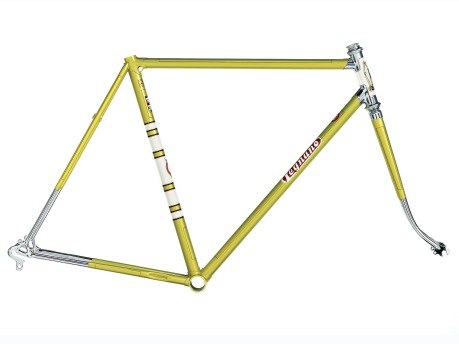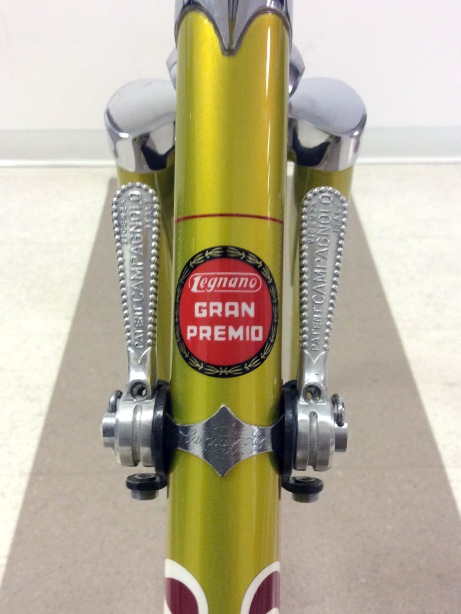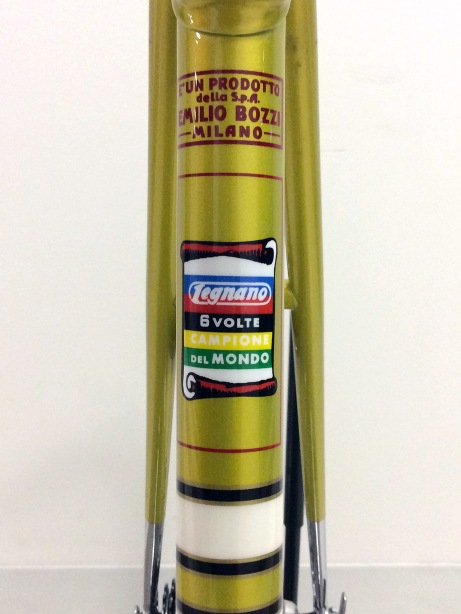As the saying goes, “a bike can be restored many times but it is only original once”. And many of the Legnano bikes in this collection are in excellent condition but for the gentle wear of good times and happy days on the road. These bikes will never see a paint booth as long as we both “are looking down at the dirt”, another favoured saying. However it has been 40+ years now since the Legnano factory closed its doors and a few of the bikes that have come to me have earned a second life.
Living in Toronto I have the good fortune to be in the same city as Noah Rosen of Velocolour, one of the very best frame refinishers in North America and certainly ‘the best’ in Canada. When it comes to restoration there is the ‘right way’ and then there is everything else. And the ‘right way’ is Noah’s way. The craft is in his heart, the dedication is in his mind and the skill in his hands is a true gift.
Noah has restored the best Italian iron for discerning customers around the world, including several Legnano frames. However in deference to Noah’s earlier efforts as well as Legnano restorations by many talented others, the enigmatic metallic ‘lizard yellow’ paint finish that defined the Legnano brand has escaped everyone. Everyone until now that is, because Noah has finally mastered it to perfection.
And so with the testing done, it is time for the real thing. Patience is a virtue as they say and I held off for a few days before making my way back to Velocolour. When I arrived, Noah had already primed the frame, and then layed down the metallic silver base that in itself has been a major part of the development work (those details by the way will remain with Noah). Noah then painted the soft white colour on the head tube and the seat tube.
Masking off the head tube and the seat tube bands, he then moved on to laying down the first coats of the elusive metallic ‘lizard yellow’ finish that is ‘Legnano’. Although paint compounds have changed completely in the past 50 years for environmental reasons, this is the same finishing sequence that was used in the Legnano factory back in the day.
I have to tell you, monitor screens just can’t do these photos justice. But for what it is worth, compare the colour of the front fork in the image below with the background image of the original 1966 Roma that surrounds this page. Not only is the colour spot on, it has all of the iridescent green characteristics in the highlights and shadows that are true to the original finish.
As a designer myself I have worked the spectrum of colour matching challenges. This challenge has been unique and I really don’t think it could get much better (although I may push Noah the remaining half of 1% on the 1958 Roma Olimpiade that is waiting in the wings). I meant to ask Noah if he could hear Emilio Bozzi’s voice in the glow of the spray booth as he put down the first layer of colour, “Perfetto Noah . . . Perfetto”.
And here we are, the finished product. You will need to click on this image to fully appreciate the workmanship that has gone into this restoration.
Every so carefully starting the assembly (click on any of the images for an enlargement).
Although the frame finish was in very poor condition, the parts were all original and in very good condition with little or no rusting to the chrome bits and pieces. I am thinking this Gran Premio must have been stored indoors for much of its life. A bit of mild polishing compound and ‘elbow grease’ will easily cleanup the oxidation on aluminium parts unless they are very badly corroded. In this case, all is good.
The decal artwork was completely redrawn for this project by a professional graphic designer as most are not 100% accurate to the original. The black and silver bands in the above photo are a good example. The gold bands were much thinner than the black band however most of the Legnano repro decals have them the same thickness and incorrect to the original. I must admit that the Emilio Bozzi decal is still not quite perfect as the stroke of the lettering is a tad heavy, something that we will correct on the next project and another reason to keep waking up in the morning.











Wow, how did you get the stripes so dam perfect and the color gorgeous. I have dark blue frame you re paint frame ?
Yes, the stripes or ‘box lining’ as they use to call it was originally done by hand in the factory and often by women. What is even more remarkable is the work of these skilled hands painting the full curve of a fender with out lifting the brush and barely a variation in the line weight. Noah Rosen does the lining around the lugs by hand, and in this case the ‘box lining’ was done by masking the stripes to razor precision. This is a lot of work and adds to the cost of the restoration however it really defines the art form of these classic bikes.
Hi I have a Legnano frame which I would like help in dating and classifying …. any help appreciated. Stuart Walker
Happy to help where I can. I will send you an email so that you can send me some pictures of the bike and the serial number/location if it has one . . . and we can go from there.
Er! Stunning. What more can be said….
Hi, I recently bought a 70’s Gran Premio ( the Reynolds 531 version) and it requires a respray. Would you think the Legnano Green is similar to the one used in Moto Guzzi motorbikes ? The reason I’m asking is that where I live (Malta, Europe) I don’t have another Gran Premio to match the colour to, and I don’t think there are any painters over here with knowledge of the old method of painting the bikes, so I thought of purchasing some paint from the local Moto Guzzi showroom ( if they can actually get it for me of course )
The paint colour of this Moto Guzzi V11 is close. The Legnano green is a little more yellow and a little less green . . . at least from the photo of this MG V11. Thanks for posting.
Hi, thanks for your reply. I’ll probably try and get it sprayed in the Moto Guzzi colour then, as I don’t really have many alternatives. I can’t ask the painter to match the colour of the frame, as it has “gone yellow-ish” with age. My only real other alternative is sending it to Italy to get it sprayed there, but it’s probably going to cost an arm and a leg heh.
Hello.
I know the owner of Magri cycles (Mosta) has one.
Did you get it painted or not yet ?
I have a Gran Premio myself and I need to likewise have it painted.
Patrick Attard
Paul has one ? I never knew, and I know him quite well 🙂 Did he buy it recently ?
I decided a long time ago (as my post was in 2016) to leave it with the original paint, as I did a lot of research and I’ve never seen a 100% accurate paint job for a Legnano except from Velocolour, and it’s not cost-effective for me to send a frame to Canada. All the other paint jobs I’ve seen aren’t accurate. The Legnano green is extremely difficult to replicate.
The real cost in a professional frame restoration is the preparation of the frame before the paint is applied. Stripping off the old paint, fine sanding, filling any nicks or scratches in the steel, masking off the chrome lugs, etc. etc. This prep has so much to do with a great paint job. And then there is the cost and work in properly applying the decals along with the protective clear coats and ultra fine wet sanding in between each. If there is new chrome plating required there is also the work of removing the old plating and preparing the surfaces for new chrome plating that has risen in cost everywhere. Almost forgot the box lining and pin striping that adds hours of work to get it right as there are few that can do it freehand and so it all has to be masked off. So on the surface of things the cost of refinishing a vintage bike frame may look steep but it involves so many hours of work to do the job right.
Yeah, I do understand that 🙂 Unfortunately on this tiny island where I live, there are no professional bike restorers, so I’ll have to either send it off to Italy or get it done by a classic car restorer. Will let you know how it goes 🙂
Given the very favourable exchange rate of the Euro to Canadian dollar, you could consider sending it to Velocolour in Toronto. Noah Rosen has the paint match, decals and numerous Legnano bikes that he has restored for me and others. And I would be happy to supervise the work for you. Just a thought as you consider your options.
Thanks, that’s very kind of you 🙂 I will see my options and take it from there , but I will definitely let you know . I can send you photos of the frame if you give me your email address ( but it’s up to you , of course )